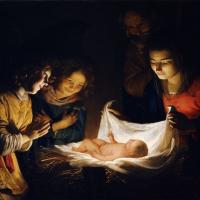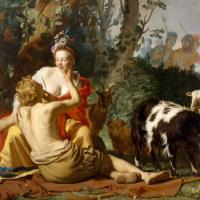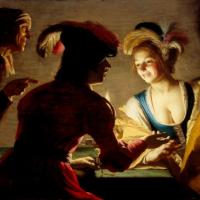Gerrit Van Honthorst
Granida And Daifilo
$540.00
The Procuress
$480.00
Gerrit Van Honthorst
Gerard van Honthorst (Gerrit van Honthorst) (4 November 1592 – 27 April 1656) was a Dutch Golden Age painter who became especially noted for his depiction of artificially lit scenes, eventually receiving the nickname Gherardo delle Notti ("Gerard of the nights"). Early in his career he visited Rome, where he had great success painting in a style influenced by Caravaggio. Following his return to the Netherlands he became a leading portrait painter.
Van Honthorst was born in Utrecht, the son of a decorative painter, and trained under his father, and then under Abraham Bloemaert.
Honthorst is often referred to as "Gherardo delle notti" ("Gerrit of the Nights") by modern Italians. However, the nickname does not actually appear in any known Italian sources dating before Honthorst's death. Surviving Italian documents from before 1656 refer to the artist as either "Gherardo Fiammingo" ("Gerrit the Fleming") or "Gherardo Hollandese" ("Gerrit the Dutchman"), emphasizing his foreignness rather than his trademark skill at rendering nocturnal lighting. It was only in the 18th century that the nickname "Gherardo delle notti" came into widespread use.
Honthorst was a prolific artist. His most attractive pieces are those in which he cultivates the style of Caravaggio, often tavern scenes with musicians, gamblers and people eating. He had great skill at chiaroscuro, often painting scenes illuminated by a single candle.
Some of his most notable pieces were portraits of the Duke of Buckingham and his family (Hampton Court), the King and Queen of Bohemia (Hanover and Combe Abbey), Marie de Medici (Amsterdam Stadthuis), 1628, the Stadtholders and their Wives(Amsterdam and The Hague), Charles Louis and Rupert, Charles I's nephews (Musée du Louvre, St Petersburg, Combe Abbey and Willin), and Baron Craven (National Portrait Gallery, London). His early style can be seen in the Lute-player (1614) in the Louvre, the Martyrdom of St John in Santa Maria della Scala at Rome, or the Liberation of Peter in the Berlin Museum.
His 1620 The Adoration of the Shepherds in the Uffizi was destroyed in the Via dei Georgofili Massacre of 1993.
Honthorst's 1623 The Concert was purchased for an undisclosed sum by the National Gallery of Art in Washington, D.C., from a private collection in France in November 2013. The painting had not been on view since 1795. The 1.23-by-2.06-metre (4.0 by 6.8 ft) The Concert went on display for the first time in 218 years in a special installation at the National Gallery of Art's West Building on November 23, 2013. It remained there for six months before going on permanent display in the museum's Dutch and Flemish galleries.






